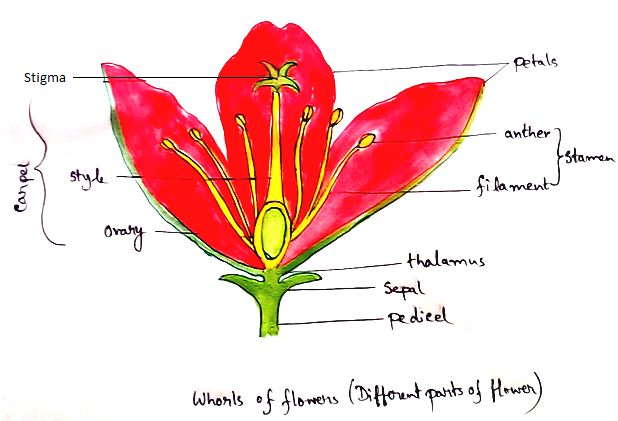Parts of a Flower
The flower is the modified shoot for reproduction.
The stalk of flower is called pedicel.
The expanded tip of the pedicel from where the floral parts arise is called thalamus.
A typical flower consists of different parts. They are
Calyx: It is the first whorl containing sepals. Sepals may be united (gamosepalous) or free (polysepalous). Sepals protect the inner part of the flower in the budding stage. Coloured sepals are called petaloid sepals. In some plants additional whorl of sepal is found below the calyx called epicalyx.
Corolla: It is made up of petals . When petals are united they are form gamopetalous and when they are free they produce polypetalous. Petals are the most attractive part of flower which attract insects. Insects come for collecting nector and by the fault they help in pollination. As a result fertilization takes place and flower is converted into fruit. If there is a structure where sepal and petals cannot be distinguished separately are called perianth.
Androecium: collective parts of the male reproduction is called androecium. It is made up of stamens. Stamen is made up of a filament,anther and connective. Anther contains pollen sacs which further contain pollen grains.
Gynoecium: Collective parts of the female reproductive parts is called gynoecium. It is the innermost whorl of flower which is called pistil. It is made up of carpels. Carpel consists of ovary, style, stigma. Ovary contains ovules. When the gynoecium has one carpel, it is called monocarpellary ,if it contains two carpels,- it is called bicarpellary and if more than two carpels are present it is called polycarpellary. If the carpels are free the gynoecium is called apocarpous. If the carpels are united is called syncarpous.
Above mentioned four whorls can be divided into essential (directly involved in reproduction), non essential (parts that help a plant in reproduction).
According to position of ovary in the flower,it can be divided into different types. They are –
A. Hypogynous – Ovary occupies the highest position on the thalamus means ovary is superior. Example- China rose.
B. Perigynous - The thalamus formed a cup-shaped structure around the ovary. Ovary is half inferior. Example- rose.
C. Epigynous – The thalamus encloses the ovary. Here the ovary is inferior. Example- sunflower.
According to presence of whorl s flowers can be divided into different types:
Complete flower: A flower which have all the four whorls (calyx, corolla,androecium, gynoecium) is called complete flower. Example, China rose, pea flower.
Incomplete flower: Any one of the whorl is missing (androecium, gynoecium) is called incomplete flower. Example- cucurbita flower.
Bisexual flower: A flower which contains both androecium and gynoecium is called bisexual flower. Example- mango.
Unisexual flowers: A flower which contains either androecium or gynoecium is called unisexual flower. Example- cucurbita.
Monoecious: A plant which has both staminate and pistillate flowers borne on the same plant. Example- corn.
Dioecious: Staminate and pistillate flowers are present on different plants. Example - Mulberry.
Question and answer on Parts of a Flower:
What is placentation?
Arrangement of ovules and placenta within an ovary is called placentation.
From Parts of a Flower to HOME PAGE
Recent Articles
-
What Is Plasma? | Blood Plasma | Proteins | Nutrients | Cholesterol
Nov 07, 25 10:29 AM
Blood is a mobile fluid which is a connective tissue and is derived from the mesoderm like cell any other connective tissue. Colour of blood is reddish and that flows inside the blood vessels by means… -
Disorders of Respiratory System | Tuberculosis | Pleurisy | Emphysema
Oct 28, 25 11:39 PM
Tuberculosis is very common disease and is caused by a type of bacteria called Mycobacterium tuberculosis. This disease causes different trouble in the respiration and infection of several parts of th… -
Regulation of Respiration | Respiratory Centres | Inspiratory Area |
Oct 14, 25 12:13 AM
Respiratory Centre is the area that controls the rate of respiration and it is observed to be located in medulla oblongata and pons. Respiratory Centre has the following will dispersed components like… -
Explain Transport of Gases | External Respiration | Tissue Respiration
Oct 09, 25 11:35 PM
In humans gaseous exchange is completed in the following ways the steps are - External Respiration or Breathing - Breathing in false taking in of Oxygen and giving out of carbon dioxide in the body. M… -
Kind and Number of Teeth | Location of Teeth in Mouth | Care of Teeth
Sep 11, 25 12:52 AM
Kind and Number of Teeth






New! Comments
Have your say about what you just read! Leave me a comment in the box below.